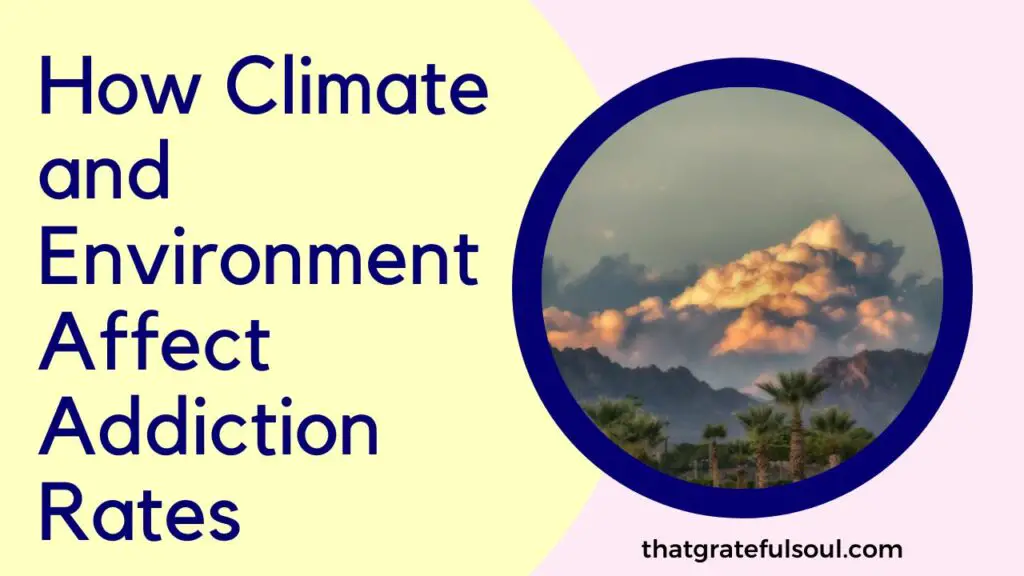In recent years, the relationship between climate, environment, and addiction rates has become an increasingly important topic of discussion.
The impact of climate change, along with various environmental factors, can significantly influence addiction rates.
As a content writer with expertise in the addiction treatment industry, understanding the interplay between these factors is crucial for providing valuable insights.
This article aims to explore the connections between climate, environment, and addiction rates, shedding light on the complex dynamics that contribute to this issue.

-
Save
Table of Contents
How Climate and Environment Affect Addiction Rates
1. Climate Change and Vulnerability
Climate change is altering the world we live in, affecting communities and individuals in profound ways. Rising temperatures, extreme weather events, and natural disasters are some of the consequences of climate change that have far-reaching implications.
Studies have shown that climate change can exacerbate existing vulnerabilities, such as socioeconomic disparities, mental health issues, and substance abuse problems.
2. Displacement and Trauma
One of the most significant impacts of climate change is the displacement of communities due to natural disasters, rising sea levels, and changing environmental conditions.
Displacement often leads to increased stress, anxiety, and trauma among affected individuals. Such emotional distress can contribute to a higher susceptibility to addiction.
Displaced individuals may resort to substance abuse as a coping mechanism, attempting to alleviate the psychological and emotional turmoil they experience.
3. Economic Hardship
Climate change can also have adverse effects on the economy, particularly in regions dependent on agriculture, tourism, or natural resources.
Extreme weather events, such as droughts or hurricanes, can devastate livelihoods, disrupt local economies, and create financial instability.
Economic hardship, coupled with limited resources and access to essential services, can heighten the risk of addiction.
Individuals facing economic uncertainty may turn to substances as a temporary escape or a means to cope with the stressors they encounter.
4. Psychological Impact
he psychological impact of climate change cannot be underestimated.
As the world faces the consequences of environmental degradation and climate-related disasters, individuals may experience a range of psychological issues, including anxiety, depression, and post-traumatic stress disorder (PTSD). These mental health conditions are often linked to substance abuse and addiction.
Individuals struggling with their mental well-being may turn to drugs or alcohol as a form of self-medication, further exacerbating the problem.
5. Environmental Factors and Substance Abuse
Apart from climate change, specific environmental factors can directly influence addiction rates. These factors include availability, accessibility, and social acceptance of substances.
Environmental cues and social norms play a crucial role in shaping an individual’s behavior and can either promote or discourage substance abuse.
6. Availability and Accessibility
The availability and accessibility of addictive substances are closely tied to addiction rates.
Environmental factors, such as the presence of liquor stores or easy access to illicit drugs, can significantly impact substance abuse patterns within communities.
Areas with high numbers of alcohol outlets or drug markets are more likely to have higher addiction rates.
Additionally, the physical proximity of these substances to individuals can increase the temptation and likelihood of abuse.
7. Social Acceptance and Norms
Social acceptance and norms regarding substance use also contribute to addiction rates.
The cultural and social environment in which an individual lives can shape their attitudes towards drugs and alcohol.
Communities that view substance use as socially acceptable or normal may experience higher rates of addiction.
Peer pressure and social influence can further reinforce substance abuse behaviors, making it difficult for individuals to break free from the cycle of addiction.
8. Prevention and Intervention Strategies
Understanding the connection between climate, environment, and addiction rates can help inform effective prevention and intervention strategies.
Addressing the root causes and providing support to vulnerable populations is essential in mitigating the impact of climate change and environmental factors on addiction rates.
- Education and Awareness: Raising awareness about the relationship between climate change, environment, and addiction rates can help individuals make informed choices and develop resilience against substance abuse.
- Community Support: Strengthening community support systems, including mental health services, addiction treatment centers, and support groups, can provide vital assistance to those affected by climate-related traumas and economic hardships.
- Policy Interventions: Implementing policies that regulate the availability and accessibility of addictive substances can help reduce addiction rates. This includes zoning restrictions, licensing regulations, and prevention programs targeting high-risk areas.
- Climate Change Mitigation: Taking action to mitigate climate change and reduce its impact is crucial for preventing the exacerbation of addiction rates. This includes transitioning to renewable energy sources, promoting sustainable practices, and advocating for climate-conscious policies.
Conclusion
The relationship between climate, environment, and addiction rates is complex and multifaceted.
Climate change and environmental factors can contribute to vulnerability, displacement, economic hardship, and psychological distress, all of which increase the risk of substance abuse and addiction.
Recognizing these connections is vital for developing effective prevention and intervention strategies to address addiction within the context of a changing climate and evolving environmental challenges.
By promoting education, community support, policy interventions, and climate change mitigation efforts, we can work towards a healthier future, both for individuals struggling with addiction and for the well-being of our planet.
-
Save

